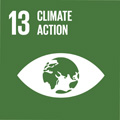- Docente: Laura Tositti
- Credits: 6
- SSD: CHIM/12
- Language: English
- Teaching Mode: Traditional lectures
- Campus: Ravenna
- Corso: Second cycle degree programme (LM) in Science for the Conservation-Restoration of Cultural Heritage (cod. 8537)
Learning outcomes
At the end of the course the student will acquire the basic knowledge of atmospheric chemical interactions on cultural properties resulting from past and present airborne pollution; connections between atmospheric composition, its historical evolution into a polluted environment as well as temporal trends will; links between a changing atmospheric chemistry and climate. Special focus will be given to ambient particulate matter and to its physico-chemical characterization in indoor and outdoor conditions, including its interactions with the gaseous phase and the resulting degradation over exposed heritage materials.
Course contents
Composition of the atmosphere under natural and polluted conditions - Evolution of atmospheric composition in the course of time, environmental archives - Major, minor and trace gases in the present atmosphere - Physical-chemistry of the greenhouse effect - Global warming and trends in atmospheric composition: climatic change and cultural heritage - Atmospheric reactivity: Oxydation capacity of the atmosphere and role of OH radical - Airborne particulate matter: size distribution, composition and formation processes - PM10 and other relevant cutoffs in airborne particulate matter - connections between particulate matter and acid rains - occult precipitation - interactions between atmospheric pollutants with materials in artistic manufacts - experimental design in air pollution monitoring - Chemical characterization of outdoor and indoor environments
Readings/Bibliography
Lesson notes
Teacher Slides
Tiwary A, Colls
J.
Air Pollution: Measurement,
Modelling & Mitigation.
Abingdon, Oxon, UK: Routledge,
Taylor & Francis group, 2010.
BRIMBLECOMBE, P.The
Big Smoke, Methuen, London (1987/88/2011) pp 185.
Teaching methods
Slides on the 4 sections in which the course is split + books and other reports or papers on specific topics on which consolidating/checking slides illustrated in the classes
Further explanations available on appointment by email
Assessment methods
3 topics discussed among those treated within the course
First topic chosen by the candidate, following ones based on question by the teacher
Teaching tools
Slides prepared by the teacher for the 4 main branches in which the course is split
Slides are complemented by textbooks, journal papers and reports for checking and consolidating contents treated in class
Further explanations/support can be provided by the teacher on appointment
Office hours
See the website of Laura Tositti
SDGs



This teaching activity contributes to the achievement of the Sustainable Development Goals of the UN 2030 Agenda.
